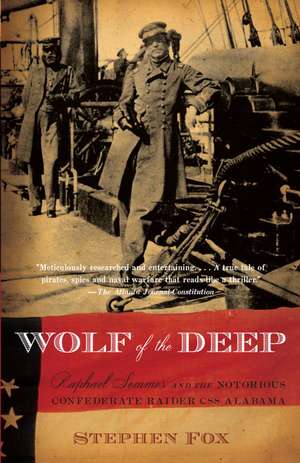Wolf of the Deep: Raphael Semmes and the Notorious Confederate Raider CSS Alabama: Vintage Civil War Library
Autor Stephen Foxen Limba Engleză Paperback – 31 iul 2008
In July, 1862, Semmes received orders to take command of a secret new British-built steam warship, the Alabama. At its helm, he would become the most hated and feared man in ports up and down the Union coast—and a Confederate legend. Now, with unparalleled authority and depth, and with a vivid sense of the excitement and danger of the time, Stephen Fox tells the story of Captain Semmes's remarkable wartime exploits. From vicious naval battles off the coast of France, to plundering the cargo of Union ships in the Caribbean, this is a thrilling tale of an often overlooked chapter of the Civil War.
Din seria Vintage Civil War Library
-
 Preț: 102.62 lei
Preț: 102.62 lei -
 Preț: 107.63 lei
Preț: 107.63 lei -
 Preț: 121.68 lei
Preț: 121.68 lei -
 Preț: 144.52 lei
Preț: 144.52 lei -
 Preț: 109.32 lei
Preț: 109.32 lei -
 Preț: 139.90 lei
Preț: 139.90 lei -
 Preț: 136.71 lei
Preț: 136.71 lei -
 Preț: 136.30 lei
Preț: 136.30 lei -
 Preț: 100.24 lei
Preț: 100.24 lei -
 Preț: 134.74 lei
Preț: 134.74 lei -
 Preț: 122.76 lei
Preț: 122.76 lei -
 Preț: 99.36 lei
Preț: 99.36 lei -
 Preț: 143.78 lei
Preț: 143.78 lei -
 Preț: 133.47 lei
Preț: 133.47 lei -
 Preț: 100.42 lei
Preț: 100.42 lei -
 Preț: 149.08 lei
Preț: 149.08 lei -
 Preț: 116.64 lei
Preț: 116.64 lei -
 Preț: 144.04 lei
Preț: 144.04 lei -
 Preț: 196.43 lei
Preț: 196.43 lei -
 Preț: 115.32 lei
Preț: 115.32 lei -
 Preț: 117.18 lei
Preț: 117.18 lei -
 Preț: 105.40 lei
Preț: 105.40 lei -
 Preț: 198.45 lei
Preț: 198.45 lei -
 Preț: 117.10 lei
Preț: 117.10 lei -
 Preț: 99.14 lei
Preț: 99.14 lei -
 Preț: 98.10 lei
Preț: 98.10 lei -
 Preț: 110.75 lei
Preț: 110.75 lei - 18%
 Preț: 71.23 lei
Preț: 71.23 lei - 16%
 Preț: 80.42 lei
Preț: 80.42 lei -
 Preț: 102.90 lei
Preț: 102.90 lei -
 Preț: 102.69 lei
Preț: 102.69 lei
Preț: 125.54 lei
Nou
Puncte Express: 188
Preț estimativ în valută:
24.02€ • 25.08$ • 19.88£
24.02€ • 25.08$ • 19.88£
Carte disponibilă
Livrare economică 15-29 martie
Preluare comenzi: 021 569.72.76
Specificații
ISBN-13: 9781400095421
ISBN-10: 1400095425
Pagini: 317
Ilustrații: B&W PHOTOS AND 2 MAPS
Dimensiuni: 133 x 202 x 17 mm
Greutate: 0.31 kg
Editura: Vintage Books USA
Seria Vintage Civil War Library
ISBN-10: 1400095425
Pagini: 317
Ilustrații: B&W PHOTOS AND 2 MAPS
Dimensiuni: 133 x 202 x 17 mm
Greutate: 0.31 kg
Editura: Vintage Books USA
Seria Vintage Civil War Library
Notă biografică
Stephen Fox, an independent historian who did his PhD at Brown University, is the author of six previous books, including Transatlantic, a history of the steamship. He lives near Boston, Massachusetts.
Extras
Chapter One: The Captain and the Ship
Like most of the military heroes of the Civil War, Raphael Semmes burst into that sudden historical spotlight after an earlier career of no particular distinction. During thirty-five years in the Navy of the United States, he had often clashed with his superiors and railed at the clogged pipelines of promotion. He seemed distracted by intellectual and literary interests, or his second career as a lawyer, or the needs and pulls of his large family. Naval colleagues such as David Dixon Porter, more single-minded than Semmes, doubted his seriousness. “While in the United States Navy, Semmes had little reputation as an officer,” Porter recalled after the war.
"He was indolent and fond of his comfort, so that altogether his associates in the Navy gave him credit for very little energy. What was, then, the astonishment of his old companions to find that Semmes was pursuing a course that required the greatest skill and vigor; for there never was a naval commander who in so short a time committed such depredations on an enemy’s commerce, or who so successfully eluded the vessels sent in pursuit of him."
Porter’s later praise and criticism of Semmes were both filtered through the distorting passions of the opposite sides they had taken in the war. Porter was himself one of the many frustrated Union pursuers of the Confederate commander, and that public failure no doubt sharpened the edges of his dismissal of the prewar Semmes. Yet his final judgment of a former colleague who was so often underestimated seems balanced and well deserved. “The inertness he had displayed while in the United States Navy had disappeared,” Porter wrote of the captain who bestrode the deck of the Alabama. “He had become a new man.”
At the core of this transformation was Semmes’s internal sense of himself as a Southerner—evolving over many years, prodded along by events, and not finally firmed until after the start of the war. His Roman Catholic ancestors had for five generations lived in the border state of Maryland, a terrain contentiously split between its free-labor northern counties and slaveowning southern regions. In Charles County, twenty-five miles south of Washington, the Semmeses of the seventeenth and eighteenth centuries grew tobacco and owned slaves. At times they attained wealth and prominence as members of the local Catholic gentry.
Raphael was born on September 27, 1809, at Effton Hills, Charles County, on the family’s tobacco farm. His only brother, Samuel, was born two years later. Their mother, Catherine Middleton Semmes, died when the boys were young. Their father, Richard Thompson Semmes, then married again and moved the family into town, to the Georgetown district of Washington, where his brothers Alexander and Raphael were thriving in business. But Richard also died young, only thirty-nine years old, leaving no money and two sons who were just fourteen and twelve. The orphans, Raphael and Samuel, were very close, often sleeping in each other’s arms.
Instead of being separated, they were delivered to the joint care of the families of Uncle Raphael and a third uncle, Benedict Joseph Semmes, a physician, farmer, and politician out in Piscataway, Prince George’s County. Even before this formal arrangement, though, young Raphael had already learned important lessons from all his uncles. In the fluid country households of the time, children moved around and spent occasional seasons with their favorite relations. Raphael later remembered being “reared on the banks of the Potomac,” acquiring the swimming skills that, in future naval combats and disasters, would save his life more than once. Another relative, Joseph Semmes, ran the City Tavern near the corners of High and Bridge streets in Georgetown. More than just a drinking joint, it functioned as a major business, transportation, and cultural center— and doubtless a fertile source of practical education for the curious young boy.
Uncle Benedict, an eminent graduate of the Baltimore Medical College with a statewide practice, taught his nephew the private joys and haven of serious reading. “The habit of study is in itself a great comfort,” Raphael later instructed one of his own children. “I formed this habit myself in early life, under the wise counsels of your Uncle Ben, and it has been a great resource to me ever since.” Though he may have spent a few years at a military academy in St. Mary’s County, and once even offhandedly referred to “the shreds and patches of our college learning,” he was essentially self-educated: a lifelong, intent autodidact, never more at home than when lost in a book.
His uncles Alexander and Raphael inspired a naval career by giving the boy a taste for salt water and distant ports. Alexander owned a fleet of merchant ships sailing out of Georgetown, down the Potomac and on to the sea. Uncle Raphael’s merchant shipping interests often took him across the Atlantic, then home with expansive stories to tell. Hanging around the ships and sailors, perhaps even venturing a quick coastal voyage, young Raphael decided to try life on the ocean. His main home, Uncle Raphael’s crowded house in Georgetown, included five other children, with more to come. It seemed time to venture out on his own. In April 1826, with the necessary political help of his well-connected Uncle Ben, he was appointed a midshipman in the U.S. Navy. The boy, not yet seventeen years old, was now a man.
Years before the founding of the Naval Academy at Annapolis in 1845, Semmes was entering a kind of apprenticeship for future naval officers. On a man-of-war, the midshipmen stood between the officers and the sailors—hence the name—taking orders from above and delivering them below. A tutor gave lessons in the arcane shipboard skills of navigation, astronomy, and artillery. The middies ate together, in messes of eight to twelve men, and slept together in the steerage. As a tight cluster of young men, they inevitably arranged themselves into a pecking order. Within this group, status depended on muscle and assertion. Raphael Semmes, small and bookish, lacked the usual credentials. It could not have been an easy initiation.
In confined circumstances at sea, with hundreds of rough men crowded into tight spaces for months at a time, often through severe and dangerous weather, survival depended on ruthless order and discipline. Every man and object claimed an assigned place. A typical Navy sailing ship of this period had four decks and three masts. (Steam power still lay in the future.) On the top deck, aft of the mainmast at the center of the vessel, the coveted quarterdeck was just for officers; midshipmen could not even set foot on its starboard side. Everyone, the captain included, had to touch his hat or cap upon entering the quarterdeck to acknowledge its significance. Toward the stern, aft of the mizzenmast, lay the raised poop deck. Ringed by bulwarks that held the sailors’ hammocks during the day, it also formed the roof of the captain’s cabin.
The ship’s clock hung over the door of this cabin. In an era when American life on shore was still gearing up to the industrial cadence of clock time, everyday shipboard routine moved to the precise, relentless ticking of that timepiece. The twenty-four hours were sliced into five watches of four hours each and two more—the dog watches—of two hours. Within each watch, the ship’s bell was struck once after thirty minutes, twice after sixty, and so on. The constant question was not What time is it? but How many bells is it? At eight bells the watch changed and men shifted in synchronized patterns among their prescribed spots (below, above, and aloft), in the clockworked rhythms of working, sleeping, and eating.
The food and water were generally terrible. Water stored in large wooden casks smelled and tasted rank; it improved slightly when iron tanks replaced the casks. The daily staples of salt beef and rice were so blandly indigestible that they made occasional dishes of salt pork and bean soup seem like treats. The hard bread, veined by worms, was often rebaked until crisp; if this didn’t improve the flavor, at least it killed the worms. The characteristic overpowering ship odor belowdecks—of cooking, rotting food, cockroaches and vermin, and human waste, all mingling in a bracing stew of bilgewater—did not improve appetites. A prolonged storm meant battened hatches and heavy, stifling air below, with all hands yearning for their first relieving gulps of the sweet oceanic atmosphere up on deck.
Yet Semmes, young and small as he was, found a place in these ships that felt comfortable and kept pulling him back. The basic social unit of shipboard life was the mess. For the middies, that meant about eight men in a small, low-ceilinged room, ten feet by ten feet, somewhere between decks. Each guy had a chest for his clothes. In the center of the room was a table for eating; off to one side, a small pantry for crockery and supplies. A lattice grating overhead let in some light and air, but the room was dark and poorly ventilated. The men were allowed only two candles a day and no open flames at night. They slept on the gun or berth decks, hanging their hammocks from hooks in the overhead beams. Like the members of an infantry unit, or harassed pledges of a college fraternity, the messmates drew together in their shared hardships and common needs—and for lighter moments too. As young men away from home for the first time, exulting in their relative freedom, they all cracked jokes and pulled pranks, and kept each other loose. Semmes even developed a betting habit that frequently cost him his month’s pay.
For Semmes, the ship functioned like a college. He excelled at the educational aspects, broadly defined. Aside from the formal shipboard instruction, he seized the many chances for self-instruction. As his later ship journals and published writings make obvious, he was fascinated by oceans and exotic ports of call. Almost anything might catch his attention: tide rips, the Gulf Stream, whales and fishes, a lunar rainbow, the alternation of land and sea breezes in tropical countries, an odd cloud of golden dust far at sea, coral reefs and the tiny creatures that built them, the landscape of the Venezuelan coast, the winds and currents at Gibraltar, the fierce storms of the North Atlantic. The Navy took him around the world, and he noticed details everywhere he went. He admired the great harbor at Rio de Janeiro. He traveled in Europe, standing on the shore of Lake Geneva and watching a storm in the Alps.
After six years, including a stint at the school in the Norfolk Navy Yard in Virginia, he ripped through the required examination and advanced to the rank of passed midshipman. Semmes thereby became eligible for promotion and collided with the aspect of naval life he came most to detest. Preparing for war, the Navy trained far too many men for the available postings in peace. When promotions did arrive, they were doled out by seniority and favoritism, not merit. For Semmes and most other officers, that meant long, slow years of waiting, with extended leaves on shore at reduced pay. He was not promoted to lieutenant until 1837. To occupy his time ashore and bring in some needed extra money, he read law with his brother, Samuel. In 1834 he was admitted to the Maryland bar. A lawyer’s work suited his studious habits and command of written language, and it remained an intermittent occupation for the rest of his life.
In the Navy, though, it helped set his reputation as, literally, a “sea lawyer,” a malcontent overly inclined to question and quibble. “As a controversialist,” a Southern colleague later recalled, “he was unequalled in the Navy.” Whenever he disagreed with a decision, or felt slighted, he could not resist speaking out: candid behavior appropriate for a private citizen but, in a military structure based on rank and deference, a pattern not endearing to his superiors or liable to advance his career. At times the issues were external, with Semmes merely responding to public reports that he thought unfair. In 1833, after a military magazine criticized his revered mathematics teacher at Norfolk, Semmes sent a sharp rebuttal to the publication. This began a lifelong pattern of firing off polemics to the editors of newspapers and magazines.
Three years later, after a steamship under his command ran aground and sank on the Withlacoochee River in Florida, the Pensacola Gazette reported that the accident had harmed a related military operation against the Seminole Indians. Semmes submitted an extended counterargument, bristling with italics, which the Gazette printed. “The public will see the undue importance which has been attached to the loss of this vessel,” he asserted. “If there is blame to be attached to myself or my officers, this will be a proper subject for a Court of Inquiry, and not for newspaper discussions.”
In 1843 Semmes clashed with his boss at the Pensacola Navy Yard, Commodore Alexander Dallas, over the appointment of a chief clerk at the yard. Instead of giving the job to the man Semmes favored, Dallas named the son of a friend. Semmes then recklessly sidestepped Dallas and sent a complaint up to the Navy Department in Washington, accusing the commodore of signing a false muster for the new clerk, who furthermore—Semmes charged—was neglecting his duties. When Dallas heard about it, he roared at Semmes and suspended him from duty for six weeks. Semmes at once wrote another broadside and tried to deliver it to Dallas. The enraged commodore menacingly stalked toward him, sending Semmes at a brisk run back to his quarters. A later court-martial cleared Dallas of any misconduct. The Navy brass surely took note of the bumptious behavior of their troublesome Lieutenant Semmes.
A career in the U.S. Navy, defending his country’s flag all around the world, reinforced for Semmes a sense of national identity over any sectional loyalty. His marriage to a woman from the North both reflected and extended the same tendency. In 1834, during one of his extended shore leaves, Semmes for obscure reasons ventured out to Cincinnati, Ohio, across the Ohio River from Kentucky. It was then a young, booming town of about 28,000 people, not long matured from the frontier. Boarding at the home of Oliver and Electra Spencer, the naval officer noticed their teenaged daughter, Anne Elizabeth. She was easy to notice. An acquaintance at the time described her as “a stately, handsome girl with regular chiseled features, brilliant brunette complexion and hazel eyes.” An early photograph adds details: dark, shiny hair parted in the middle and gathered at the nape of her neck, a tiny waist, and a steady, composed gaze at the camera.
Her father came from an old New England Yankee family. Oliver Spencer was born in New Jersey, then as a boy moved to the Ohio frontier with his family. In 1792, at the age of ten, he was kidnapped by Indians. For seven months he lived and moved with them, in reasonable contentment, until a British agent bought him back. (Later Spencer wrote a short book about his captivity, a deadpan narrative bearing no anger, and his Indian guardian paid him an annual friendly visit.) Settled in Cincinnati, he at first enjoyed a successful career in banking and river commerce. By 1815 he was president of the Miami Exporting Company. But its bank failed five years later, swallowing the savings of many customers. An angry mob marched on the bank and almost sacked it. In the messy aftermath, Spencer managed to keep his family’s fine house on Sixth Street, between Broadway and Sycamore, but he had lost a fortune and his good name.
From the Hardcover edition.
Like most of the military heroes of the Civil War, Raphael Semmes burst into that sudden historical spotlight after an earlier career of no particular distinction. During thirty-five years in the Navy of the United States, he had often clashed with his superiors and railed at the clogged pipelines of promotion. He seemed distracted by intellectual and literary interests, or his second career as a lawyer, or the needs and pulls of his large family. Naval colleagues such as David Dixon Porter, more single-minded than Semmes, doubted his seriousness. “While in the United States Navy, Semmes had little reputation as an officer,” Porter recalled after the war.
"He was indolent and fond of his comfort, so that altogether his associates in the Navy gave him credit for very little energy. What was, then, the astonishment of his old companions to find that Semmes was pursuing a course that required the greatest skill and vigor; for there never was a naval commander who in so short a time committed such depredations on an enemy’s commerce, or who so successfully eluded the vessels sent in pursuit of him."
Porter’s later praise and criticism of Semmes were both filtered through the distorting passions of the opposite sides they had taken in the war. Porter was himself one of the many frustrated Union pursuers of the Confederate commander, and that public failure no doubt sharpened the edges of his dismissal of the prewar Semmes. Yet his final judgment of a former colleague who was so often underestimated seems balanced and well deserved. “The inertness he had displayed while in the United States Navy had disappeared,” Porter wrote of the captain who bestrode the deck of the Alabama. “He had become a new man.”
At the core of this transformation was Semmes’s internal sense of himself as a Southerner—evolving over many years, prodded along by events, and not finally firmed until after the start of the war. His Roman Catholic ancestors had for five generations lived in the border state of Maryland, a terrain contentiously split between its free-labor northern counties and slaveowning southern regions. In Charles County, twenty-five miles south of Washington, the Semmeses of the seventeenth and eighteenth centuries grew tobacco and owned slaves. At times they attained wealth and prominence as members of the local Catholic gentry.
Raphael was born on September 27, 1809, at Effton Hills, Charles County, on the family’s tobacco farm. His only brother, Samuel, was born two years later. Their mother, Catherine Middleton Semmes, died when the boys were young. Their father, Richard Thompson Semmes, then married again and moved the family into town, to the Georgetown district of Washington, where his brothers Alexander and Raphael were thriving in business. But Richard also died young, only thirty-nine years old, leaving no money and two sons who were just fourteen and twelve. The orphans, Raphael and Samuel, were very close, often sleeping in each other’s arms.
Instead of being separated, they were delivered to the joint care of the families of Uncle Raphael and a third uncle, Benedict Joseph Semmes, a physician, farmer, and politician out in Piscataway, Prince George’s County. Even before this formal arrangement, though, young Raphael had already learned important lessons from all his uncles. In the fluid country households of the time, children moved around and spent occasional seasons with their favorite relations. Raphael later remembered being “reared on the banks of the Potomac,” acquiring the swimming skills that, in future naval combats and disasters, would save his life more than once. Another relative, Joseph Semmes, ran the City Tavern near the corners of High and Bridge streets in Georgetown. More than just a drinking joint, it functioned as a major business, transportation, and cultural center— and doubtless a fertile source of practical education for the curious young boy.
Uncle Benedict, an eminent graduate of the Baltimore Medical College with a statewide practice, taught his nephew the private joys and haven of serious reading. “The habit of study is in itself a great comfort,” Raphael later instructed one of his own children. “I formed this habit myself in early life, under the wise counsels of your Uncle Ben, and it has been a great resource to me ever since.” Though he may have spent a few years at a military academy in St. Mary’s County, and once even offhandedly referred to “the shreds and patches of our college learning,” he was essentially self-educated: a lifelong, intent autodidact, never more at home than when lost in a book.
His uncles Alexander and Raphael inspired a naval career by giving the boy a taste for salt water and distant ports. Alexander owned a fleet of merchant ships sailing out of Georgetown, down the Potomac and on to the sea. Uncle Raphael’s merchant shipping interests often took him across the Atlantic, then home with expansive stories to tell. Hanging around the ships and sailors, perhaps even venturing a quick coastal voyage, young Raphael decided to try life on the ocean. His main home, Uncle Raphael’s crowded house in Georgetown, included five other children, with more to come. It seemed time to venture out on his own. In April 1826, with the necessary political help of his well-connected Uncle Ben, he was appointed a midshipman in the U.S. Navy. The boy, not yet seventeen years old, was now a man.
Years before the founding of the Naval Academy at Annapolis in 1845, Semmes was entering a kind of apprenticeship for future naval officers. On a man-of-war, the midshipmen stood between the officers and the sailors—hence the name—taking orders from above and delivering them below. A tutor gave lessons in the arcane shipboard skills of navigation, astronomy, and artillery. The middies ate together, in messes of eight to twelve men, and slept together in the steerage. As a tight cluster of young men, they inevitably arranged themselves into a pecking order. Within this group, status depended on muscle and assertion. Raphael Semmes, small and bookish, lacked the usual credentials. It could not have been an easy initiation.
In confined circumstances at sea, with hundreds of rough men crowded into tight spaces for months at a time, often through severe and dangerous weather, survival depended on ruthless order and discipline. Every man and object claimed an assigned place. A typical Navy sailing ship of this period had four decks and three masts. (Steam power still lay in the future.) On the top deck, aft of the mainmast at the center of the vessel, the coveted quarterdeck was just for officers; midshipmen could not even set foot on its starboard side. Everyone, the captain included, had to touch his hat or cap upon entering the quarterdeck to acknowledge its significance. Toward the stern, aft of the mizzenmast, lay the raised poop deck. Ringed by bulwarks that held the sailors’ hammocks during the day, it also formed the roof of the captain’s cabin.
The ship’s clock hung over the door of this cabin. In an era when American life on shore was still gearing up to the industrial cadence of clock time, everyday shipboard routine moved to the precise, relentless ticking of that timepiece. The twenty-four hours were sliced into five watches of four hours each and two more—the dog watches—of two hours. Within each watch, the ship’s bell was struck once after thirty minutes, twice after sixty, and so on. The constant question was not What time is it? but How many bells is it? At eight bells the watch changed and men shifted in synchronized patterns among their prescribed spots (below, above, and aloft), in the clockworked rhythms of working, sleeping, and eating.
The food and water were generally terrible. Water stored in large wooden casks smelled and tasted rank; it improved slightly when iron tanks replaced the casks. The daily staples of salt beef and rice were so blandly indigestible that they made occasional dishes of salt pork and bean soup seem like treats. The hard bread, veined by worms, was often rebaked until crisp; if this didn’t improve the flavor, at least it killed the worms. The characteristic overpowering ship odor belowdecks—of cooking, rotting food, cockroaches and vermin, and human waste, all mingling in a bracing stew of bilgewater—did not improve appetites. A prolonged storm meant battened hatches and heavy, stifling air below, with all hands yearning for their first relieving gulps of the sweet oceanic atmosphere up on deck.
Yet Semmes, young and small as he was, found a place in these ships that felt comfortable and kept pulling him back. The basic social unit of shipboard life was the mess. For the middies, that meant about eight men in a small, low-ceilinged room, ten feet by ten feet, somewhere between decks. Each guy had a chest for his clothes. In the center of the room was a table for eating; off to one side, a small pantry for crockery and supplies. A lattice grating overhead let in some light and air, but the room was dark and poorly ventilated. The men were allowed only two candles a day and no open flames at night. They slept on the gun or berth decks, hanging their hammocks from hooks in the overhead beams. Like the members of an infantry unit, or harassed pledges of a college fraternity, the messmates drew together in their shared hardships and common needs—and for lighter moments too. As young men away from home for the first time, exulting in their relative freedom, they all cracked jokes and pulled pranks, and kept each other loose. Semmes even developed a betting habit that frequently cost him his month’s pay.
For Semmes, the ship functioned like a college. He excelled at the educational aspects, broadly defined. Aside from the formal shipboard instruction, he seized the many chances for self-instruction. As his later ship journals and published writings make obvious, he was fascinated by oceans and exotic ports of call. Almost anything might catch his attention: tide rips, the Gulf Stream, whales and fishes, a lunar rainbow, the alternation of land and sea breezes in tropical countries, an odd cloud of golden dust far at sea, coral reefs and the tiny creatures that built them, the landscape of the Venezuelan coast, the winds and currents at Gibraltar, the fierce storms of the North Atlantic. The Navy took him around the world, and he noticed details everywhere he went. He admired the great harbor at Rio de Janeiro. He traveled in Europe, standing on the shore of Lake Geneva and watching a storm in the Alps.
After six years, including a stint at the school in the Norfolk Navy Yard in Virginia, he ripped through the required examination and advanced to the rank of passed midshipman. Semmes thereby became eligible for promotion and collided with the aspect of naval life he came most to detest. Preparing for war, the Navy trained far too many men for the available postings in peace. When promotions did arrive, they were doled out by seniority and favoritism, not merit. For Semmes and most other officers, that meant long, slow years of waiting, with extended leaves on shore at reduced pay. He was not promoted to lieutenant until 1837. To occupy his time ashore and bring in some needed extra money, he read law with his brother, Samuel. In 1834 he was admitted to the Maryland bar. A lawyer’s work suited his studious habits and command of written language, and it remained an intermittent occupation for the rest of his life.
In the Navy, though, it helped set his reputation as, literally, a “sea lawyer,” a malcontent overly inclined to question and quibble. “As a controversialist,” a Southern colleague later recalled, “he was unequalled in the Navy.” Whenever he disagreed with a decision, or felt slighted, he could not resist speaking out: candid behavior appropriate for a private citizen but, in a military structure based on rank and deference, a pattern not endearing to his superiors or liable to advance his career. At times the issues were external, with Semmes merely responding to public reports that he thought unfair. In 1833, after a military magazine criticized his revered mathematics teacher at Norfolk, Semmes sent a sharp rebuttal to the publication. This began a lifelong pattern of firing off polemics to the editors of newspapers and magazines.
Three years later, after a steamship under his command ran aground and sank on the Withlacoochee River in Florida, the Pensacola Gazette reported that the accident had harmed a related military operation against the Seminole Indians. Semmes submitted an extended counterargument, bristling with italics, which the Gazette printed. “The public will see the undue importance which has been attached to the loss of this vessel,” he asserted. “If there is blame to be attached to myself or my officers, this will be a proper subject for a Court of Inquiry, and not for newspaper discussions.”
In 1843 Semmes clashed with his boss at the Pensacola Navy Yard, Commodore Alexander Dallas, over the appointment of a chief clerk at the yard. Instead of giving the job to the man Semmes favored, Dallas named the son of a friend. Semmes then recklessly sidestepped Dallas and sent a complaint up to the Navy Department in Washington, accusing the commodore of signing a false muster for the new clerk, who furthermore—Semmes charged—was neglecting his duties. When Dallas heard about it, he roared at Semmes and suspended him from duty for six weeks. Semmes at once wrote another broadside and tried to deliver it to Dallas. The enraged commodore menacingly stalked toward him, sending Semmes at a brisk run back to his quarters. A later court-martial cleared Dallas of any misconduct. The Navy brass surely took note of the bumptious behavior of their troublesome Lieutenant Semmes.
A career in the U.S. Navy, defending his country’s flag all around the world, reinforced for Semmes a sense of national identity over any sectional loyalty. His marriage to a woman from the North both reflected and extended the same tendency. In 1834, during one of his extended shore leaves, Semmes for obscure reasons ventured out to Cincinnati, Ohio, across the Ohio River from Kentucky. It was then a young, booming town of about 28,000 people, not long matured from the frontier. Boarding at the home of Oliver and Electra Spencer, the naval officer noticed their teenaged daughter, Anne Elizabeth. She was easy to notice. An acquaintance at the time described her as “a stately, handsome girl with regular chiseled features, brilliant brunette complexion and hazel eyes.” An early photograph adds details: dark, shiny hair parted in the middle and gathered at the nape of her neck, a tiny waist, and a steady, composed gaze at the camera.
Her father came from an old New England Yankee family. Oliver Spencer was born in New Jersey, then as a boy moved to the Ohio frontier with his family. In 1792, at the age of ten, he was kidnapped by Indians. For seven months he lived and moved with them, in reasonable contentment, until a British agent bought him back. (Later Spencer wrote a short book about his captivity, a deadpan narrative bearing no anger, and his Indian guardian paid him an annual friendly visit.) Settled in Cincinnati, he at first enjoyed a successful career in banking and river commerce. By 1815 he was president of the Miami Exporting Company. But its bank failed five years later, swallowing the savings of many customers. An angry mob marched on the bank and almost sacked it. In the messy aftermath, Spencer managed to keep his family’s fine house on Sixth Street, between Broadway and Sycamore, but he had lost a fortune and his good name.
From the Hardcover edition.
Recenzii
“Meticulously researched and entertaining. . . . A true tale of pirates, spies and naval warfare that reads like a thriller.” —The Atlanta Journal-Constitution“Excellent. . . . An amazing account of adventures on the high seas, full of spies, treachery, and rousing battles.”—The Charleston Post & Courier “Rollicking. . . . A virtuoso display of historical sleuthing [with] more than enough high seas excitement and intimate revelations to keep the reader turning the pages well into the night.”—The Mobile Press-Register “Amazing. . .sheds light on a seldom observed aspect of [the Civil] War.”—The Tennessean
Descriere
Entertaining and highly informative, this book is at once an account of the overlooked naval side of the Civil War, an intimate portrait of life at sea, and an overdue appreciation of Raphael Semmes, a great naval commander.












